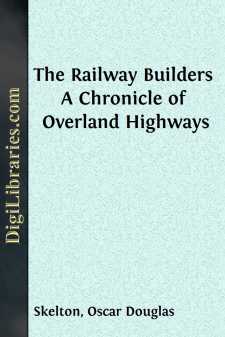Categories
- Antiques & Collectibles 13
- Architecture 36
- Art 48
- Bibles 22
- Biography & Autobiography 813
- Body, Mind & Spirit 139
- Business & Economics 28
- Children's Books 12
- Children's Fiction 9
- Computers 4
- Cooking 94
- Crafts & Hobbies 4
- Drama 346
- Education 46
- Family & Relationships 57
- Fiction 11825
- Games 19
- Gardening 17
- Health & Fitness 34
- History 1377
- House & Home 1
- Humor 147
- Juvenile Fiction 1873
- Juvenile Nonfiction 202
- Language Arts & Disciplines 88
- Law 16
- Literary Collections 686
- Literary Criticism 179
- Mathematics 13
- Medical 41
- Music 40
- Nature 179
- Non-Classifiable 1768
- Performing Arts 7
- Periodicals 1453
- Philosophy 64
- Photography 2
- Poetry 896
- Political Science 203
- Psychology 42
- Reference 154
- Religion 509
- Science 126
- Self-Help 81
- Social Science 81
- Sports & Recreation 34
- Study Aids 3
- Technology & Engineering 59
- Transportation 23
- Travel 463
- True Crime 29
The Railway Builders A Chronicle of Overland Highways
Description:
Excerpt
CHAPTER I
THE COMING OF THE RAILWAY
The Coming of the Railway—The Iron Road—The New Power—Engine and Rail—The Work of the Railway
On the morning of October 6, 1829, there began at Rainhill, in England, a contest without parallel in either sport or industry. There were four entries:
Braithwaite and Ericsson's Novelty.
Timothy Hackworth's Sans-pareil.
Stephenson and Booth's Rocket.
Burstall's Perseverance.
These were neither race-horses nor stagecoaches, but rival types of the newly invented steam locomotive. To win the £500 prize offered, the successful engine, if weighing six tons, must be able to draw a load of twenty tons at ten miles an hour, and to cover at least seventy miles a day. Little wonder that an eminent Liverpool merchant declared that only a parcel of charlatans could have devised such a test, and wagered that if a locomotive ever went ten miles an hour, he would eat a stewed engine-wheel for breakfast!
The contest had come about as the only solution of a deadlock between the stubborn directors of the Liverpool and Manchester Railway, or tramway, then under construction, and their still more stubborn engineer, one George Stephenson. The railway was nearly completed, and the essential question of the motive power to be used had not yet been decided. The most conservative authorities thought it best to stick to the horse; others favoured the use of stationary steam-engines, placed every mile or two along the route, and hauling the cars from one station to the next by long ropes; Stephenson, with a few backers, urged a trial of the locomotive. True, on the Stockton and Darlington Railway, the first successful public line ever built, opened four years before, a Travelling Engine, built by the same dogged engineer, had hauled a train of some forty light carriages nearly nine miles in sixty-five minutes, and had even beaten a stage-coach, running on the highway alongside, by a hundred yards in the twelve miles from Darlington to Stockton. But even here the locomotive was only used to haul freight; passengers were still carried in old stage-coaches, which were mounted on special wheels to fit the rails, and were drawn by horses. The best practical engineers in England, when called into consultation, inspected the Stockton road, and then advised the perplexed directors to instal twenty-one stationary engines along the thirty-one miles of track, rather than to experiment with the new Travelling Engine.
'What can be more palpably absurd and ridiculous,' the Quarterly Review had declared in 1825, 'than the prospect held out of locomotives travelling twice as fast as stage-coaches! We should as soon expect the people of Woolwich to suffer themselves to be fired off upon one of Congreve's ricochet rockets as trust themselves to the mercy of such a machine, going at such a rate.' And the Quarterly was not alone in its scepticism. The directors of the new railway had found great difficulty in obtaining a charter from parliament—a difficulty registered in a bill for parliamentary costs reaching £27,000, or over $4000 a mile....


